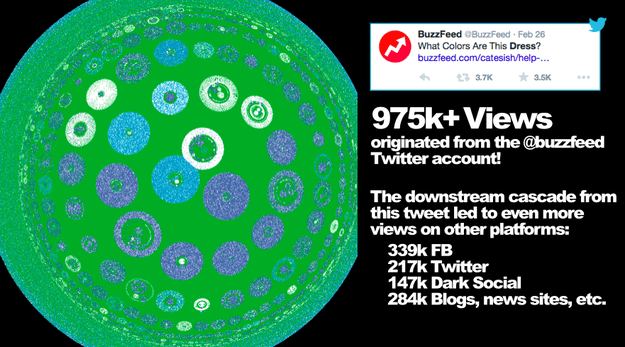BuzzFeed is known as the king of viral content, and today it’s sharing more details about a new technology showing how that content actually spreads.
By using what it calls Pound (short for Process for Optimizing and Understanding Network Diffusion), BuzzFeed promises to go beyond just counting social media shares and clicks. In a blog post, BuzzFeed Publisher Dao Nguyen writes:
Traditional web analytics provide limited insight about the social web. They can “bucket” a story’s viewers according to where they clicked from, and tell us how many are in each bucket. That data is valuable and especially suited to a “pre-sharing” world. But traditional web analytics are fundamentally unable to capture what actually happens on the social web today; they obliterate its inherent tree structure.
With Pound, on the other hand, Nguyen says BuzzFeed can track how a story progresses from user to another, even if it’s across social networks or via Gchat and email. At the same time, it’s not collecting personally identifiable information, instead tracking story sharing as “an oscillating, anonymous hash in a sharer’s URL as a UTM code.”

So what has BuzzFeed learned so far? Nguyen says there have been three big insights.
First, stories aren’t just shared through a single “tree” structure, but rather multiple trees that spring up around initial sharers, creating a broader “forest” of sharing. Second, social networks can drive an entire “downstream cascade” of sharing. For example, Pound shows that Twitter accounted for 975,000 views of BuzzFeed’s post about The Dress, but only a fraction of those were actually clicks from Twitter (as you can see in the graphic above). Third, BuzzFeed says sponsored content is shared just like regular editorial content.
A BuzzFeed spokesperson told me there are no plans to share Pound data more broadly, at least not yet.
Nguyen is also talking about the new technology at BuzzFeed’s NewFronts event for advertisers, and I’ll update my post from the event.
Update: Nguyen just got off stage, where she said BuzzFeed is looking for beta testing partners who can help the company turn Pound into a useful product for advertisers. She also talked about data that BuzzFeed gathers to categorize videos based on whether they offer information, emotion or appeal to a viewer’s identity — turns out that informational videos do better on YouTube, while identity-driven videos do better on Facebook.
And BuzzFeed founder Jonah Peretti offered some context for these new tools, specifically a braoder move towards “distributed media” — in other words, a world where a lot of BuzzFeed’s content isn’t consumed on BuzzFeed itself. On a simple level, he said that leads to a different publishing process, where there’s a core team of people making content, but they’ll publish that content to different places — sometimes to the web, sometimes to BuzzFeed’s app, and sometimes to distributed platforms like YouTube and Facebook.
In fact, Peretti said BuzzFeed’s traffic is already distributed pretty evenly across those channels. It has about 1 billion monthly views on the web, versus 700 million on apps and 1 billion on distributed platforms. The key is to make sure BuzzFeed can make money from those views and collect data about them. (Peretti said the lack of data is why BuzzFeed has avoided working with traditional media like TV so far.)
“So as long as we can have scale and impact, we don’t care about where people consume our media,” he added.
